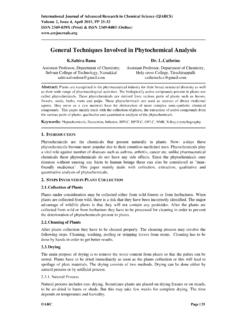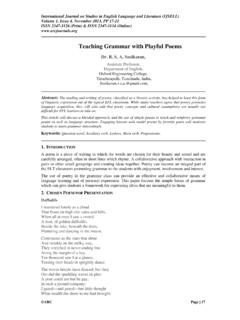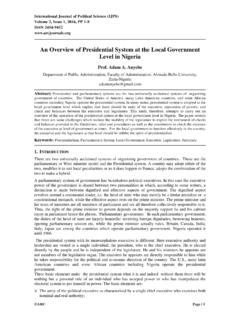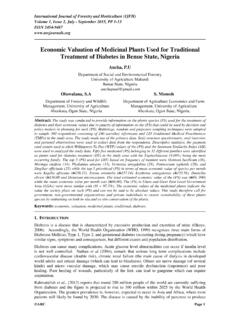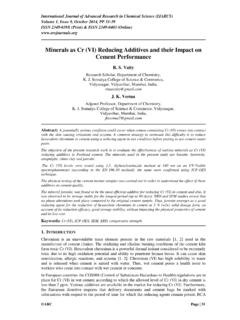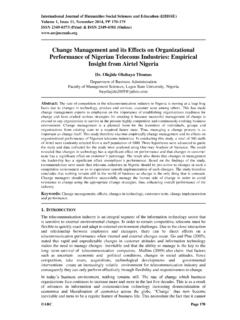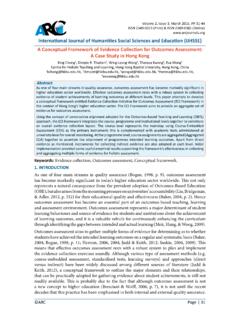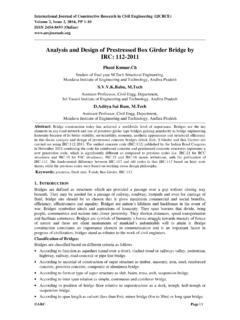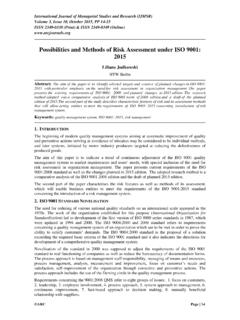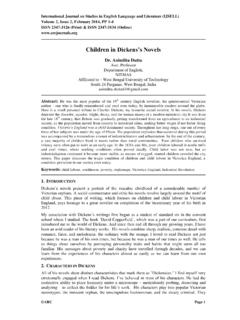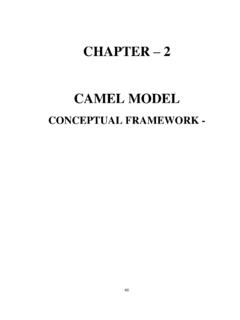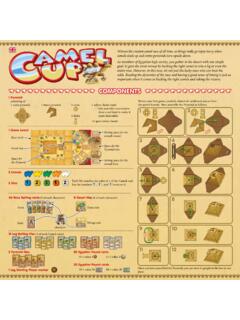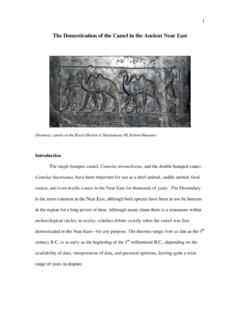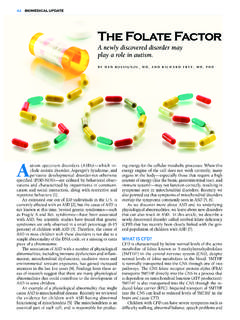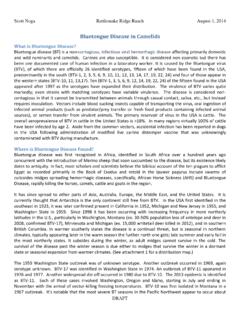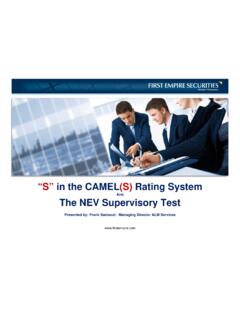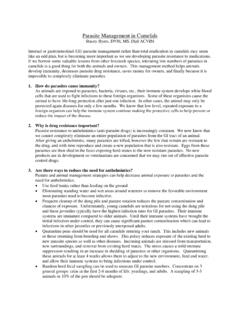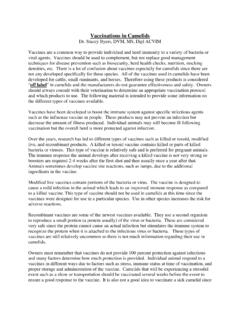Transcription of Chemical Composition and Medicinal Values of Camel Milk
1 International Journal of Research Studies in Biosciences (IJRSB). Volume 4, Issue 4, April 2016, PP 13-25. ISSN 2349-0357 (Print) & ISSN 2349-0365 (Online). Chemical Composition and Medicinal Values of Camel Milk Kula Jilo1, Dechasa Tegegne2. Jimma University, School of Veterinary Medicine Jimma, Ethiopia 1. Jilo Kula, Dechasa Tegegne, Jimma university school of veterinary medicine: Chemical Composition and Medicinal Values of Camel milk: Review. Abstract: Out of million Camel populations on the world 89% are one-humped camels and the remaining 11% are the two-humped. More than 60% of the dromedary Camel population is concentrated in the arid areas of North East African countries. Ethiopia ranks third by the number of Camel population and second by Camel milk production from the globe. Camel milk, white gold of the desert is more similar to human milk. It differs from other mammals milk as its Chemical Composition is low cholesterol, low sugar, high minerals, high vitamin C and higher protective proteins like lactoferrin, lactoperoxidase, immunoglobulins and lysozyme, lacks B-lactoglobulin.
2 -lactoglobulin Camel milk is unique in terms of antioxidative factors, antibacterial, antiviral, antifungal, anti-hepatitis, anti arthritis, treatment for paratuberculosis, preventies aging, remedy for autoimmune diseases and it has cosmetic Values . Insulin in Camel milk is safe and efficacious in improving long- term glycemic control in diabetic patient. Camel milk reduces autism symptoms in children. Lactoferrin has ability to inhibit the proliferation of cancer cell. Camel milk is rich in magnesium and zinc thus endowed antiulcer properties. Camel milk has high -hydroxyl acids which are known to plump and smoothies the skin and also used to treat skin disorders such as dermatitis, Acne, Psoriasis and Eczema. Although Camel milk has such Values , it's less appreciated thus its consumption is restricted to pastoral area so further studies should be conducted on the Chemical Composition and Medicinal value of Camel milk. Keywords: Camel milk, Chemical Composition , Medicinal value 1.
3 INTRODUCTION. As stimation of Food and Agriculture Organization (2013) the total population of Camel in the world is believed to be million, of which 89% are one-humped dromedary camels (Camelusdromedarius) and the remaining 11% are the two-humped (Camelusbactrianus) that generally found in the cold deserts of Asia while more than 60% of the dromedary Camel population is concentrated in the arid areas of North East African countries like Somalia, Sudan, Ethiopia and ranks third in the world by the number of Camel herd after Somalia and Sudan (Simeneh et al.,2015). For desert people in Asia and Africa, Camel is vital to daily life as a source of food and a means of transportation, and just as importantly, its milk has been used as medicines for diverse ailments since ancient times(Gader et al.,2016). Camel can produce more milk for a longer period of time in arid zones and harshy environment than any other domestic livestock species(Ahmed et al., 2015).The daily yield of Camel milk ranges from 3 to 10 kg in a lactation period of 12 to 18 months (Gizachew et al.)
4 , 2014).Ethiopia which possesses about million heads camels ranks second in Camel milk production in the world next to Somalia. The annual Camel milk production in Ethiopia is estimated as 75,000 tones (Asres and Yusuf, 2014). Camel milk so called white gold of the desert is more similar to human milk than any other milk and differs from other ruminant milk because it contains low cholesterol, low sugar, high minerals (sodium, potassium, iron, copper, zinc and magnesium), high vitamin C,protective proteins like as lactoferrin, lactoperoxidase,immunoglobulins, lysozyme (Yadav et al., 2015). Camel milk has been acknowledged for a long time to provide a potential treatment for a series of diseases such as dropsy, jaundice, anti-hypertensive, asthma, and leishmaniasis or kala-azar. (Asresie et al., 2014 and Yardav et al., 2015). ARC Page | 13. Jilo Tache Kula & Dechasa Tegegne It has been reported that Camel milk contains the low quantity of -casein and the lack of - lactoglobulin wich cause allergic reaction in lactose intolerant person (Konuspayeva et al.
5 , 2009). Nevertheless, it contains insulin-like and protective protein used for the treatment of many ailments like diabetes, autism, and diarrhea and possesses anti-tumors properties (Gul et al., 2015). Moreover, Camel milk is endowed with very strong immune system (Grader et al., 2016) and remedy for peptic ulcers anti-malignant (Korashy et al., 2012) anti-platlet and anti-thrombotic properties (Abdelgadir et al., 2013). More recently, studies confirmed that Camel s milk is unique in terms of antioxidative factors, antibacterial, antiviral, antifungal, anti-hepatitis, treatment for paratuberculosis, hypoglycaemic activity, anticancer, preventives of aging, remedy for autoimmune diseases, cosmetic and detergents (Al-Juboori et al., 2013, Sharma et al. ,2014, Keskes, 2015). A numerous reviews have been carried out in different milking animals despite these all benefets Chemical Composition and Medicinal Values of Camel milk was not reviewed which created information gap in the area.
6 Therefore in the line with the above, the objectives of this paper are:- To review available information on Chemical Composition and Medicinal Values of Camel milk. To recommend further investigation concerning Chemical Composition and Medicinal Values of Camel milk based on the information from this review. 2. LITERATURE REVIEW. Chemical Composition of Camel Milk Camel s milk is generally an opaque white color and has a faint sweetish odor and sharp taste; some times it can be salty (Abbas, 2013). Its opaque white color because of the fats are finely homogenized throughout the milk where as, the changes in taste are caused by the type of fodder and availability of drinking water (Yadav et al., 2015). Its density ranges from and the pH from , both are lower than those of the cow s milk and maximum buffering capacity of skim milk is at pH. (Gul et al., 2015). According to most authors the Composition of Camel milk varies due to difference of geographical origin and year of publication of the published datas but other factors such as the physiological stage, feeding conditions, seasonal or physiological variations, genetic or health status of Camel have also a paramount importance(Konuspayeva , 2009).
7 In genaral the average amount of components of Camel milk is protein ; fat ; lactose ; ash , while water covers 87% (Kanhal and Hamad, 2010). Table1. Chemical Composition of milk of different species Proximate Water % Protein % Fat % Ash % Lactose %. Camel 86-88 Cow 85-87 Buffalo 82-84 Sheep 79-82 Goat 87-88 Human 88-89 Source: (Kanhal and Hamad, 2010). Proteins Milk proteins are a heterogeneous group of compounds that differ in Composition and properties (Gizachew et al., 2014). Dromedary Camel milk contains 3 to percent of protein (table 1). It contains two main groups (Caseins and Whey proteins and relatively higher amount immune proteins (Peptidoglycan Recognition Protein, Lactoferrin Lysozyme and Lactoperoxidase) and insulin (Abbas et al., 2013, Gul et al., 2015). Casein is the most important and higher in proportion, while the proportion of whey proteins is relatively low (Guo et al., 2007). Shamsia (2009) also comfirmed that Camel milk contains higher protein (especially casein) and lower in whey milk than human milk.)
8 Casein is a major part of protein in Camel milk. Dromedary Camel milk has to percent of casein protein that constitutes 52 to 87 percent of total milk protein (Khaskheli et al., 2005). There are International Journal of Research Studies in Biosciences (IJRSB) Page | 14. Chemical Composition and Medicinal Values of Camel Milk 4 main casein fractions casein: s1-, s2-, -, and . their proportion is diverse and polymorphism of these proteins was demonstrated in most of the animal species (Bar owska, 2007). The human casein does not contain the s1-fraction, which is the predominant factor causing milk protein allergy. However; it is rich in the -fraction. But casein in cow and buffalo milk is very abundant ( and of total casein, respectively) in the s1-fraction (Zicarelli, 2004). Milk protein allergy (MPA). is an allergic reaction to proteins commonly found in cow milk. In whole casein portion, -CN is 65. percent and s1-CN is 21 percent. Camel milk has more digestibility and less allergic reactions in infants as s-CN slowly hydrolyze than -CN (El-Agamy et al.)
9 , 2009). Whey protein is the second biggest fraction of protein of Camel milk which covers 20 to 25 percent of Camel milk protein. The milk of dromedary Camel has a whey protein in range of and percent (Khaskheli et al., 2005). -lactoglobulin is found in trace, while -lactalbumin comprises the major Camel milk portion. In the milk of bovines, -lactalbumin constitute only 25 percent, while - lactoglobulin made 50 percent of the total whey protein that make it the major whey protein of bovine milk(Laleye et al., 2008). Whey protein of Camel milk consists of some other main components such as peptidoglycan, recognition protein, immunoglobulins, lactoferrin and serum albumin (Kappeler et al., 2005). Peptidoglycan Recognition Protein (PGRP); its highest concentration was first discovered in Camel milk and it has apparent effect on breast cancer by controlling metastasis an stimulates the host s immune response (Gizachew et al., 2014). It stimulates the host s immune response and has potent antimicrobial activity.
10 It even appears to have an effect on breast cancer in studies (Gul et al., 2015). Lactoferrin is a glycoprotein which has an ability to bind two metal cations (preferably Fe 3+) to the binding sites that are structurally closely majority of lactoferrin is needed for transportation or storage of iron and posses antioxidant properties.. Lactoferrin contents of Camel milk ( ) were significantly higher than goat, sheep, buffalo and cow milk (Abas et al.,2013).The research of El-Hatmi(2007) revealed that highest level of lactoferrin( ) was noticed after 2 days of parturition. Lactoferrin is among the protective proteins in Camel milk with higher concentration and thus prevents microbial overgrowth and invading pathogens (Hosam HM et al., 2013). Lactoperoxidase is resistant to acidic and proteolytic digestion contributes to the non-immune host defense system, exerting bactericidal activity,growth promotion activity, anti-tumor activity and it has a close relation (71%) to human thyroid peroxidase, which is involved in iodination and coupling in the formation of the thyroid hormones(Mullaicharam et al.)
